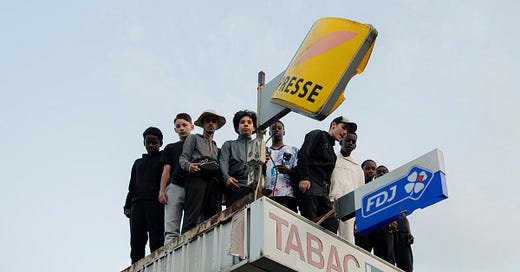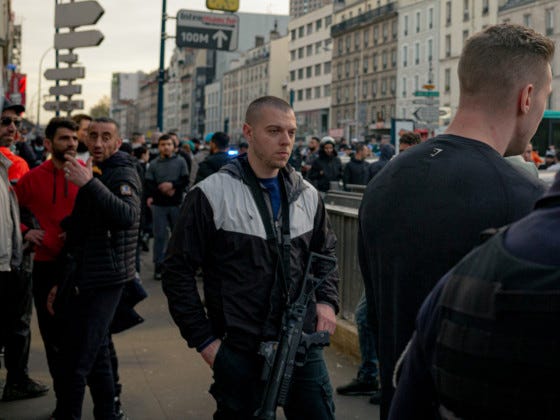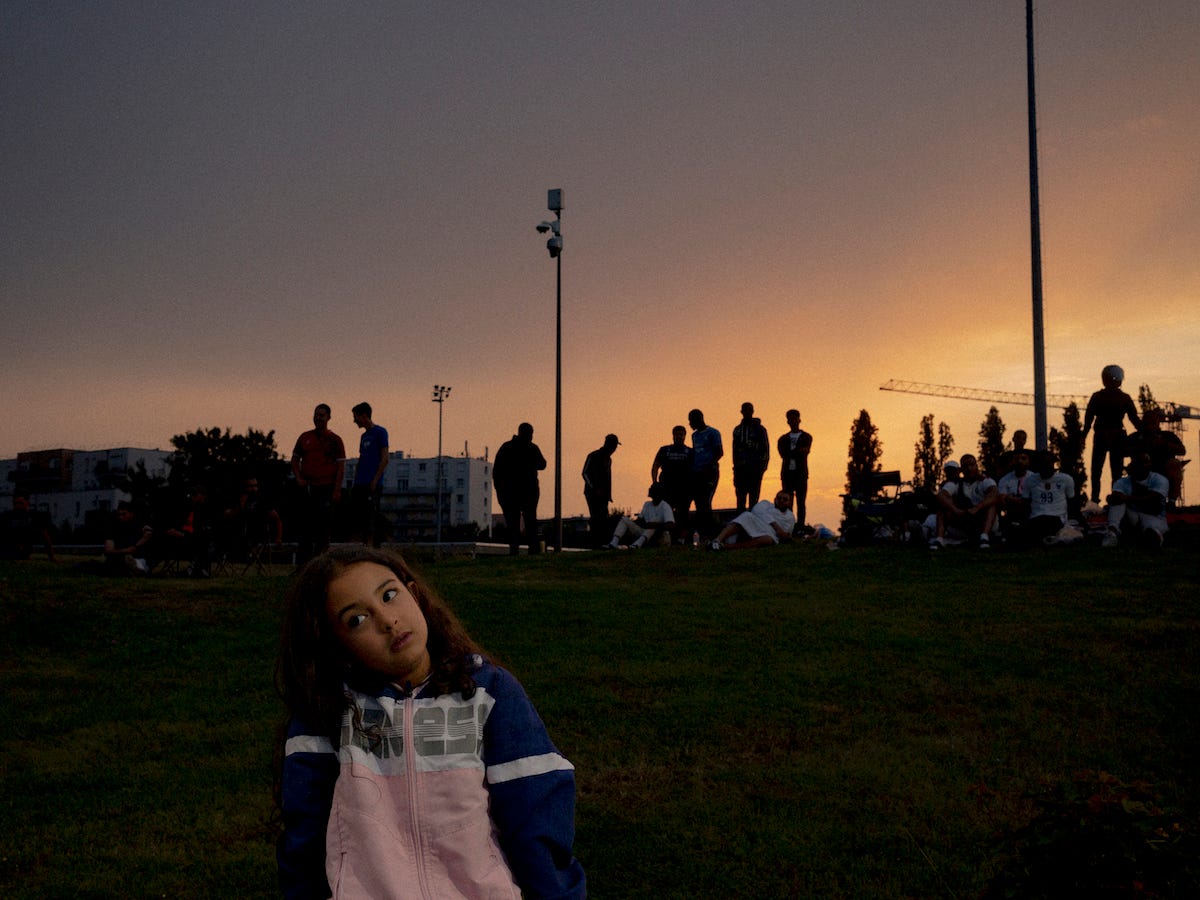8 September 2023. Post-growth | France
How to live without growth // Photographing the streets of the Paris banlieue
Welcome to Just Two Things, which I try to publish three days a week. Some links may also appear on my blog from time to time. Links to the main articles are in cross-heads as well as the story. A reminder that if you don’t see Just Two Things in your inbox, it might have been routed to your spam filter. Comments are open.
1: How to live without growth
The first part of a two-part review of Kate Soper’s book Post-Growth Living: For an alternative hedonism. The second part will appear on Tuesday.
Obviously we need to stop pretending that we are going to fix climate change without some changes in behaviour by consumers in the global North. Usually this is an outcome that is described as politically unacceptable because it is portrayed as wearing hairshirts and a diet of nothing but nettle leaves.
But it is not as if consumer capitalism is offering particularly good outcomes, even for those who have done well out of it. Debt levels are high, depression and and mental illness are increasing, we see an increasing number of consumption-based health effects, from obesity to allergies. This is all in the present, even discounting the terrible medium to long term effects if carbon emissions push us above 1.5 degrees of warming.
And if you give people the chance to work less without impoverishing themselves, they generally take it. So I have been wondering idly for a while if there are ways to propose lifestyle changes that make people happier and better, and also reduce their consumption and their emissions.
Fortunately for me the philosopher Kate Soper has been wondering about this less idly than I have, in her book Post Growth Living: For An Alternate Hedonism. (The book was published in 2020: the paperback is recently out. Thanks to Ian Christie for the prompt.)
(Photo: Andrew Curry. CC BY-NC-SA 4.0)
She sets out the issue reasonably succinctly early on.
(G)reen thought and writing, hitherto overly centred on the depletion of the natural world, now needs to focus less on the destruction of nature and its impact on a - supposedly unreformable - consumerist way of living, and more on human political culture and its reconstruction. (p13).
And after that there are a couple of chapters of position squaring, where she teases out differences between her intended argument and other ‘green/red’ critics of capitalism, and then reminds us of the scale of the climate emergency. It’s necessary work, of course, in a critique like this, and chapter 2 is a useful review of current critiques of capitalism, but the argument doesn’t get started until around page 50:
alternative hedonism dwells on the pleasures to be gained by adopting a less high-speed, consumption-oriented way of living. Instead of presaging gloom and doom for the future, it points to the ugly, puritanical and self-denying aspects of the high-carbon lifestyle in the present... Its advocates believe that new forms of desire - rather than fears of ecological disaster - are more likely to encourage sustainable modes of consuming. (p50)
Soper doesn’t use the phrase “weak signals”, but in effect that is what she is describing when she discusses the practices of alternative hedonism. She borrows a phrase from the Marxist critic Raymond Williams, “structures of feeling”, to describe that sense that change is happening even if it is not yet appearing in the data. (Williams’ contemporary, the pioneering French ‘red-green’ thinker Andre Gorz also gets dragged into the light here, which is always welcome.)
The weak signals unfold here, more or less, in a set of chapter sub-headings: streets that have been reclaimed from the car; a more local world; having less need for new stuff (the fast fashion industry gets a beating from time to time); and owning less and sharing more.
That’s all very well, but consumerism does also fulfil needs, whether we like it or not. Yes, some consumerism is a result of the way that our economic systems work, supported by the vast expensive structures of our advertising and marketing industries, no matter what advertisers tell themselves when they look in the mirror in the morning.
(As an aside here, she critiques the notion of the ‘Anthropocene’ as a label for our current era on the grounds that it implies that all humans are responsible, when we know that in practice it has been a subset of humans engaged in a particular economic system.)
On the other hand, credible researchers like Colin Cooper and Daniel Miller argue that consumerism helps to construct meaning (I’d say: for those who can afford it). It’s also a source of social affirmation and approval. So:
Sustainable alternatives to it would also have to provide for distinctively human forms of need, and meet our appetite for novelty, excitement, distraction, self-expression (p56).
The second part will appear in Just Two Things on Tuesday.
2: Photographing the streets of the Paris banlieue
The Parisian banlieues are difficult to explain, away from their specific geography, but—like the vast American housing projects—they are a very particular form of using the built environment and the power of the state to ensure social stratification. Or, to borrow from Wikipedia:
Beginning in the 1970s, the term banlieue has taken on a particular connotation, becoming a popular word for economically-deprived suburbs featuring low-income housing projects that are home to large immigrant populations.
Both inside and outside of France, they tend to attract attention only when riots flare up, which is quite often. We hear about the ‘hot’ violence, but not the ‘slow’ violence. So it was interesting to read in Magnum, the news photography collective, that a French-Cambodian photographer, William Keo, brought up in St Denis, had returned home to photograph the banlieue.
Here are some extracts from the article and a couple of photographs, which are, of course, his copyright.
(Young people on a roof. Verneuil-sur-Seine, France, 2023. All images © William Keo / Magnum Photos.)
On the banlieue’s reputation for rioting:
“Riots is just one chapter in the story,” Keo explains. “It is the result of a serious lack of dialogue between the government and the people, as well as growing social exclusion.” Earlier this year, Keo documented the demonstrations and riots that took place after the death of Nahel Merzouk, a 17-year-old from a suburb of Paris, and a demonstration in honor of Adama Traoré, who died in police custody in July of 2016. “More than ever, the episodes of violence in France following Nahel’s death are the result of a historical process strongly influenced by socio-economic factors, racial struggles and social violence,” he states.
He’s been working on the project since 2019, and it now represents a significant body of work. If there is a theme here, it is about forms of social exclusion. He started close to him home in St Denis, photographing “the migrant communities living in and around the cities of Saint-Denis and Aubervilliers, documenting their daily lives”.
(A police officer from the anti-crime brigade (BAC) in the street. Blanc-Mesnil, France, 2022. All images © William Keo / Magnum Photos.)
For the last year, he has focused on particular groups and institutions:
a prison in Villepinte which has over double the number of inmates than its “maximum” capacity in 2022, to accompanying the emergency services in Saint-Denis, and following the “anti-crime brigade,” a civilian police force that intervene on small and medium crimes... “The way these services work is representative of the state, and how people are treated in the area,” he explains.
More recently, he has turned his camera towards the young people in the area, the teenagers with nothing to do:
“Halfway between adolescence and adulthood, young people from the French banlieues are often wondering about their future,” he explains. “They spend so much time dreaming, wanting to do something, make a living beyond the housing estates where they live. There’s not much to do, but people have so much passion and ambition that they have to channel it somewhere.”
(Spectators during a match at the "African Cup of Nations," a community-organized event in Aulnay-sous-Bois. France, 2022. All images © William Keo / Magnum Photos.)
Keo posts updates of his work to Instagram.
Notes from readers: biodiversity
Charlene Rohr, who read my piece last weekend about the King’s College meadow, and who happens to live in Cambridge, sent me this extra information about it:
King’s College is sharing the seeds generated by the meadow with local schools. So that glorious meadow is creating many more.
j2t#494
If you are enjoying Just Two Things, please do send it on to a friend or colleague.






